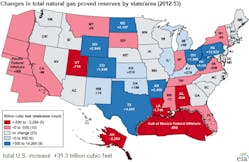Source: U.S. Energy Information Administration, U.S. Crude Oil and Natural Gas Proved Reserves
Note: * data withheld to avoid disclosure of individual company data
U.S. total natural gas proved reserves increased 10 percent (31 trillion cubic feet (Tcf)) in 2013 and reached a new U.S. record of 354 Tcf, according to newly published data in the U.S. Energy Information Administration's U.S. Crude Oil and Natural Gas Proved Reserves, 2013.
At the state level, Pennsylvania and West Virginia reported the largest increases in natural gas proved reserves in 2013, driven by continued development of the Marcellus Shale gas play in the Appalachian Basin. Pennsylvania added 13.5 Tcf of proved natural gas reserves, an increase of 37 percent in 2013. West Virginia had the second-largest increase, an addition of 8.3 Tcf (56 percent) of natural gas proved reserves. Combined, these two states had 70 percent of the net increase in U.S. natural gas proved reserves in 2013.
Texas, which benefits from having the Barnett and Eagle Ford Shale plays within its borders, had the third-largest increase in 2013—a 5 percent gain (4.4 Tcf of proved reserves). Proved reserves of natural gas in shale gas plays accounted for 45 percent (159.1 Tcf) of all U.S. natural gas reserves in 2013.
Alaska had the largest decline in natural gas proved reserves in 2013, the result of deteriorating well performance in certain oil fields. The two fuels are linked because most (87 percent) of Alaska's natural gas reserves are within reservoirs that also contain and produce crude oil.
Changes in reserves reflect both geological and financial factors. In 2012, low natural gas prices led to significant downward revisions to the reserves of existing natural gas fields. As natural gas prices increased in 2013, a portion of those reserves from existing fields were restored by positive net revisions. Other increases in natural gas reserves came from extensions of existing natural gas fields and new discoveries.
EIA's estimates of proved reserves are based on an annual survey of domestic oil and gas well operators. For more information, read the full U.S. Crude Oil and Natural Gas Proved Reserves, 2013 report.
Source: U.S. Energy Information Administration, U.S. Crude Oil and Natural Gas Proved Reserves
Note: * data withheld to avoid disclosure of individual company data



